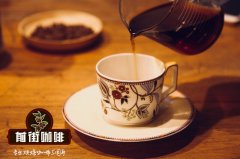Is the aroma of flowers and fruits of coffee beans determined by roasting? How to flush out the sweetness of coffee

Professional coffee knowledge exchange more coffee bean information please follow the coffee workshop (Wechat official account cafe_style)
When we get a boutique coffee bean, the outer package is always printed with a series of messages: producing area, manor, altitude, variety, baking degree, flavor and so on. Each kind of information is an important factor to measure the quality and flavor of coffee beans.
Because, the flavor of coffee beans is established step by step from the local soil that raised it to the way of treatment. But how can we accurately understand the flavor of coffee through this information?
Why this coffee bean from Ethiopia can show a rich fruit flavor.
one
Flavor determined by soil and cultivation system
Altitude
The altitude of coffee producing areas is regarded as an important factor affecting the quality of coffee beans. The Ethiopian Sakuran of this issue is located at a high altitude of 2250-2350m.
Compared with the planting area at low altitude, the temperature in the high altitude area is lower and the temperature difference between day and night is large. Just like why Xinjiang cantaloupe is delicious, the temperature difference slows the growth of coffee, and the contents of sucrose, organic acids, trigonelline and fruit esters are higher in coffee fruits.
Therefore, the density of high-altitude coffee beans is higher and the organic matter is more abundant. In flavor, the acidity is outstanding, there is a pleasant fruit flavor, such as grapefruit, citrus, berries and so on.
On the other hand, the density of coffee beans at low altitude is lower, and the flavor is balanced but mediocre.
For boutique beans, although there are still beans with good flavor at low altitude, high altitude has been recognized as an important parameter to measure the quality of coffee beans.
Therefore, based on the advantage of altitude, this issue of Ethiopia Sakuran can show a rich fruit flavor: passion fruit, guava, strawberry jam, sweet and sour berries, apricot.
Cultivation system
The best growing area for coffee trees is the country with alpine terrain between the Tropic of Cancer.
In these areas, different cultivation systems will also directly affect the flavor of coffee. In Ethiopia, for example, the cultivation system of coffee can also be divided into forest coffee, semi-forest coffee, pastoral coffee and plantation coffee.
Among them, forest and semi-forest coffee are almost wild: wild coffee trees are distributed in the forest, and red fruits are picked by coffee farmers in the forest during the season under the protection of the government. Or go into the forest regularly to prune and do simple maintenance.
In this almost primitive state, coffee trees are all mixed species, and the flavor is naturally richer.
For this reason, when you taste our Ethiopian Sakuran, you can experience rich spice aromas such as cinnamon from the bright fruit aromas.
Coffee tree species
Coffee tree species is an important factor affecting taste. But like any kind of plant, there are too many coffee trees to remember.
However, what you should know is the veteran tin card (Typica), with superior aroma and mild sour taste, Indonesia Mantenin, Jamaica Blue Mountain, and Yunnan Xiaogi, etc., are all derived from tin pickups.
In addition, there are also bourbon species (Bourbon), which belong to the same senior class, with mellow thickness, strong aroma and bright sweetness.
In this issue, the Ethiopian Sakuran, its coffee tree variety is called Heirloom.
Strictly speaking, family heirloom is not a specific tree species. Because there are so many kinds of coffee beans in Ethiopia, like the natural gene bank in Arabica, there are so many varieties that they are difficult to classify.
In order to protect the local coffee beans, the government is also unwilling to disclose specific variety information, so it is collectively called the native species Heirloom.
two
Treatment mode
The Ethiopian Sakuran in this issue uses the method of sun treatment. There are three common ways to treat coffee beans: sun exposure, water washing and honey treatment. And the sun is the oldest coffee processing process.
Traditionally, Ethiopia has adopted the dripping method of not touching the sun since ancient times: the water is naturally removed by sunlight and heat, and when it is needed to sell, the dried fruit is mashed and removed from the market.
Sun-dried beans have many advantages: they can better retain organic matter such as fat, acid and sugar of beans, showing a richer fragrance.
However, there are too many uncontrollable factors in the sun. If there are too many defective beans, there will be a variety of indescribable game: bleached water, tofu milk, onions, and even durian and chicken shit.
In this issue, Mr. Li Lin, the bean hunter, made use of modern technology and exquisite processing techniques to overcome the defects of the sun.
Therefore, this Ethiopian Sakuran fully highlights the advantages of the sun while eliminating strange game: the rich fruit aroma given by the producing area shows a more bizarre passion fruit flavor under the sun treatment.
And this strange fruit flavor is limited to sun-dried beans.
three
Baking technique
Chen Hao, the roaster of this coffee subscription program, is deeply aware that the flavor of coffee is formed by a mixture of various factors.
Therefore, the same tree species will show different flavors in different producing areas.
For example, the same Kaddura tree species, grown at Carnett Manor in the Tara Pearl region of Costa Rica, is treated with raisin honey and is flavored with wine grapes, passion fruits, strawberries, black tea and toffee.
In the Pitar producing area of Cymbidium Province, Colombia, after washing, its flavor is cocoa, hazelnut, caramel and almonds.
Therefore, how to show a bean more accurately and stereoscopically and restore its origin attribute to the maximum extent is his pleasure.
If we read the popular science books on coffee, we will know that coffee roasting is mainly divided into light roasting, moderate roasting and heavy roasting. In the baking process, the baking degree can be controlled by the phenomenon of "one explosion" and "two explosions".
But for Chen Hao, this is all appearances, and the focus of baking is on the display of the Mena reaction. Specifically, it is the important node at which the caramelization reaction begins in the Memena reaction.
The Mena reaction is a complex chemical reaction that is widely found in food cooking, and it is this reaction that gives coffee aroma to the nostrils.
Chen Hao believes that in the baking process, lengthening the reaction time will increase the hierarchical sense of flavor; increasing firepower and shortening the reaction time will reduce the hierarchical sense of flavor, but increase the intensity of flavor.
The aromas of flowers and fruits of coffee are the products of Mena's most intense reaction.
The aromas of nuts, caramel and chocolate are the products after 170 degrees.
For example, for this issue of Ethiopian Sakuran, which belongs to flower-scented sour coffee, you should refer to the following baking curve:
He believes that lengthening the reaction time of 150C-170C can increase the diversity and hierarchy of flavors in the Mena stage, and increase firepower after 170C for strong sweetness and a little nutty aroma.
Based on the above principles, Chen Hao will repeatedly test and test the coffee during roasting until he finds out the most perfect curve and flavor. And what is the most perfect curve?
Chen Hao believes that the most perfect curve should be able to maximize the restoration of its origin attribute, so that baristas and consumers can clearly feel the personality of beans.
This issue of Ethiopian Sakuran was also born in this process.
Sakuran, who belongs to the Goro estate in Ethiopia, is blended into a cup of bright and translucent tropical fruit: passion fruit, guava, strawberry jam, sweet and sour berries and apricots. And the simplicity that belongs to the Hambella girl is filled with a faint smell of spice.
Important Notice :
前街咖啡 FrontStreet Coffee has moved to new addredd:
FrontStreet Coffee Address: 315,Donghua East Road,GuangZhou
Tel:020 38364473
- Prev

Why do coffee beans have floral flavor? how to make floral coffee? what are the flavor characteristics?
Professional coffee knowledge exchange more coffee bean information Please follow the coffee workshop (Wechat official account cafe_style) A floral coffee and its production method, including: first carry out bean selection treatment, then carry out baking operation, and then raise beans after falling to room temperature, then grind the coffee beans into powder, while the petals are roasted separately, dried to caramelization, cooled and ground
- Next

How to make coffee by hand without flavor? how to adjust the brewing parameters
Professional coffee knowledge exchange more coffee bean information Please pay attention to coffee workshop (Wechat official account cafe_style) drinking coffee is really just a way of life, when it comes to coffee, always be careful to say that you don't understand, even if you drink it, you just drink it casually. Whether this cautious attitude is modest or not, whether you know coffee or not is really not that important to most people. IM
Related
- Beginners will see the "Coffee pull flower" guide!
- What is the difference between ice blog purified milk and ordinary milk coffee?
- Why is the Philippines the largest producer of crops in Liberia?
- For coffee extraction, should the fine powder be retained?
- How does extracted espresso fill pressed powder? How much strength does it take to press the powder?
- How to make jasmine cold extract coffee? Is the jasmine + latte good?
- Will this little toy really make the coffee taste better? How does Lily Drip affect coffee extraction?
- Will the action of slapping the filter cup also affect coffee extraction?
- What's the difference between powder-to-water ratio and powder-to-liquid ratio?
- What is the Ethiopian local species? What does it have to do with Heirloom native species?

